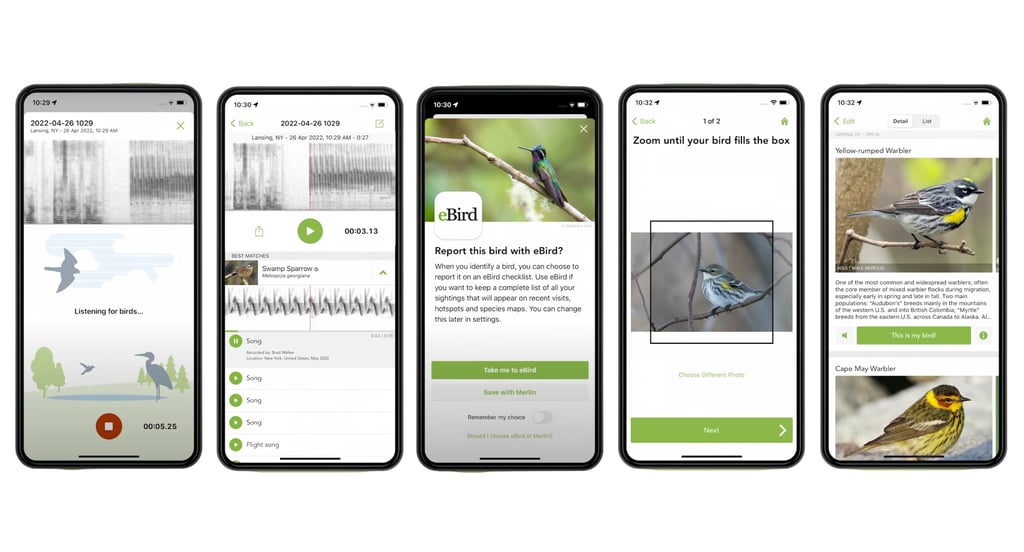For birders, spotting a flash of feathers and not knowing its name can be frustrating, especially when the bird flies off before you can log it. As you explore the world of ornithology, the best AI birding apps will give you the best of the birdwatching experience. AI tools for birders can now identify bird species from photos, recognize bird sounds in real time, and even map migration patterns or track avian visitors automatically.
Here’s a quick list of the best AI tools for birders.
Merlin Bird ID: Best for all-around bird identification
Merlin Bird ID, created by the Cornell Lab of Ornithology, remains the gold standard among AI birding apps. It features two powerful identification modes — Photo ID and Sound ID. Simply snap a photo of a bird, or upload one from your camera roll, and the AI app will offer a short list of possible matches.
What makes it even better is that the Photo ID feature works completely offline, so you can identify birds no matter where you are, whether you’re in a birding camp or just observing from your backyard.
Its Sound ID feature runs in real time, suggesting which bird is singing while you listen, while the Photo ID analyzes pictures for matches. Picture this: you’re out on a morning walk, and you hear a rapid trill from the trees, and you open Merlin’s sound ID. It then detects a Northern Parula, so you take a snap of a small, yellow-tinged bird, and the app confirms it again.
In addition to photo and sound recognition, Merlin also guides you through quick visual questions to suggest likely matches with Bird ID Wizard and lets you build a digital life list of every species you’ve identified with Save My Bird. Plus, you can get personalized recommendations for your region and season, showing which birds you’re most likely to spot nearby with the app’s eBird tool.
BirdNET: Best for bird sound recognition
BirdNET, developed by the Cornell Lab of Ornithology and Chemnitz University of Technology, is an AI platform that identifies birds purely by their sounds. It uses machine learning to detect and classify avian sounds, helping both researchers and everyday birders monitor species across the globe.
As an AI app, BirdNET listens to short audio clips and compares their patterns, tones, and frequencies against a massive database of known bird calls, delivering instant matches for over 3,000 species. Just record a snippet of a birdsong, and BirdNET will tell you whether it’s a House Wren or a distant warbler passing through.
As a research platform, BirdNET powers large-scale studies in bioacoustics and conservation, operating on everything from smartphones to Raspberry Pi and cloud systems. It serves as a citizen science platform and analysis software for extensive collections of audio, providing innovative tools for conservationists, biologists, and birders alike.
While it’s a powerful analysis platform, BirdNET is wonderfully simple for everyday use. Simply open the app, point your phone toward the source of the sound, and hit record. Then, BirdNET will detect birds and suggest possible matches, including confidence levels and location data.
iNaturalist: Best for AI and human collaboration
iNaturalist blends AI identification with global crowdsourcing. Here’s how it works: record your observations, share them with fellow naturalists, and discuss your findings to contribute to biodiversity science.
Upload a photo or a sound clip, and the AI app suggests possible species using machine learning trained on millions of community-submitted observations. From there, other naturalists confirm or correct your ID, which strengthens your birding skills and the app’s accuracy.
Beyond quick identifications, iNaturalist offers a full set of features that help you become a better birder. You can keep track of your encounters and maintain a life list in the cloud, crowdsource identifications from experts around the world, and create valuable data that helps scientists and resource managers.
You can also invite users to join or launch citizen science projects, participate in community challenges like Bioblitzes (where people record as many species as possible in a set area), and learn about nature with other enthusiasts.
Bottom line: AI tools help birders see, hear, and share smarter
The best AI tools for birders not only identify the bird call or species but also convert sightings into valuable data for the broader scientific community. These AI apps combine bird identification with community science and real-time data to help you understand not only which birds you’re seeing, but also why they’re there.
Whether you’re using AI tools to decode bird calls at dawn or are interested in contributing to biodiversity research, these apps can make birding more accurate, connected, and rewarding than ever.
The post Best AI Tools for Birders appeared first on eWEEK.

No Responses